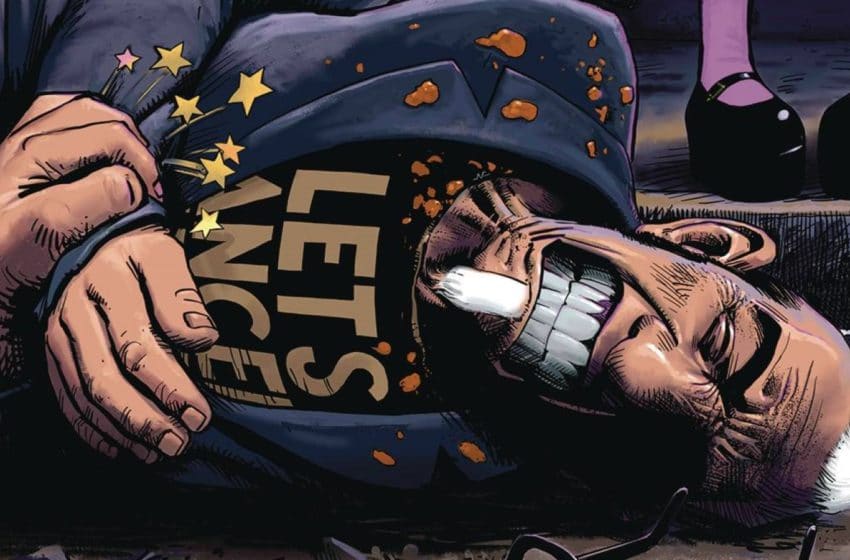Meet Janie “Strummer” Jones, just an ordinary werewolf private investigator, trying to make it on the mean streets of Los Angeles. When the case of a lifetime falls into her lap, it’s up to her and her djinn assistant Ben Si’lat to figure out just how many silver bullets have been used, and just where do silver bullets come from anyway? Let’s howl at the moon with Black’s Myth #1, written by Eric Palicki, drawn by Wendell Cavalcanti and lettered by Rob Steen for AHOY Comics.
Black’s Myth has a lot of things I really like to see in comics – it’s a detective story, in black and white, and it’s got a werewolf. I’ll take the djinn as a nice bonus, too.
That said, while this first issue has some great moments and sets up an interesting second issue, it feels more like an Issue #0 than a proper first issue.
Black’s Myth uses the familiar detective-sidekick conceit to mixed effect. Sure, the detective is a werewolf and the sidekick is a djinn, but in terms of actual character, they fall a little flat. Strummer, the werewolf, is reckless and world-weary, but in a way that feels too familiar. Ben, the djinn, appears mainly to spend all his time being concerned for Strummer except for a moment where he goes too far in interrogating Strummer’s would-be murderer, resulting in them running into traffic and dying. The question of whether Ben intended to kill the man, or at least didn’t care what happened to him, gives him an extra level of texture.
The actual mystery doesn’t start until the last page. This issue deals with a standard private detective adultery stakeout that may tie into the larger story, as well as an attempt on Strummer’s life by a Nazi-adjacent group. While interesting, this entire issue feels like foreshadowing, introducing groups and characters who may come back into play some time later, but it isn’t until the arrival of Rainsford Black late in the issue that it feels like Black’s Myth actually kicks off. So much time is spent establishing our characters, their abilities and the general setting that it feels like writer Eric Palicki was trying to get all the legwork out of the way before getting to the interesting story. And the hook the issue ends on is a good one, just overly delayed.

Wendell Cavalcanti’s black-and-white art is what keeps this first issue engaging. The backgrounds are detailed and character faces emotive. Never does the issue get too cluttered or hard to parse, as often happens when artists accustomed to working in color move to black and white. Cavalcanti makes excellent use of heavy black shading, casting everything in a deep noir shadow. Strummer’s werewolf transformation, and the subsequent fight, is an amazing sequence, and the justified centerpiece of the issue. The layouts are maybe a little too standard – everything seems to be rendered in perfect squares – but that’s more of a nitpick than anything.
I knew I had to write about Black’s Myth when I got to Page 20, when Strummer claims she only transforms involuntarily “after St. Lucia’s Day, the Pentecost and Midsummer. Those are the nights when I travel into hell and battle the devil to stop him from stealing the harvest.” My history senses instantly started tingling, and an alarm went off in my apartment. Palicki is making a joke here about Old Thiess, the Livonian Werewolf, who famously admitted in court (in the 1790s) that he was a werewolf, but a good werewolf, and a good Christian (this ploy did not work out legally, surprise, and he was exiled).
The Old Thiess joke grabbed my attention not just because it was funny, or because I recognized it, but because it suggests that Palicki has done some serious reading on supernatural figures in history – similarly, his description of the grim, Strummer’s faithful spectral companion, suggests an awareness of European folklore.
Urban fantasy often has a bad reputation, unhelped by paperback novels with half-naked women sold at the front of Barnes & Nobles nationwide, but I like Palicki’s historicist approach. There are lots of weird, interesting folkloric behaviors attached to werewolves, grims and djinn that go underexplored in media which resort to the common-denominator depictions we’ve seen in movies since the ’50s. The major plot hook that ends this issue, that Black is looking for silver bullets cast from Judas’ 30 pieces of silver, makes me think Palicki is going to be working along at least pseudo-historical lines.
On its own, this first issue feels a little weak and a little scattered. It does its job, though, which is convincing me to read the second issue. The advantage of a slow start like this is that next issue Palicki can hit the gas on the plot with the worldbuilding out of the way. At the very least, check this out for Cavalcanti’s evocative black-and-white art, which fills the book with noir energy.
Ian Gregory is a writer and co-host of giant robots podcast Mech Ado About Nothing.




